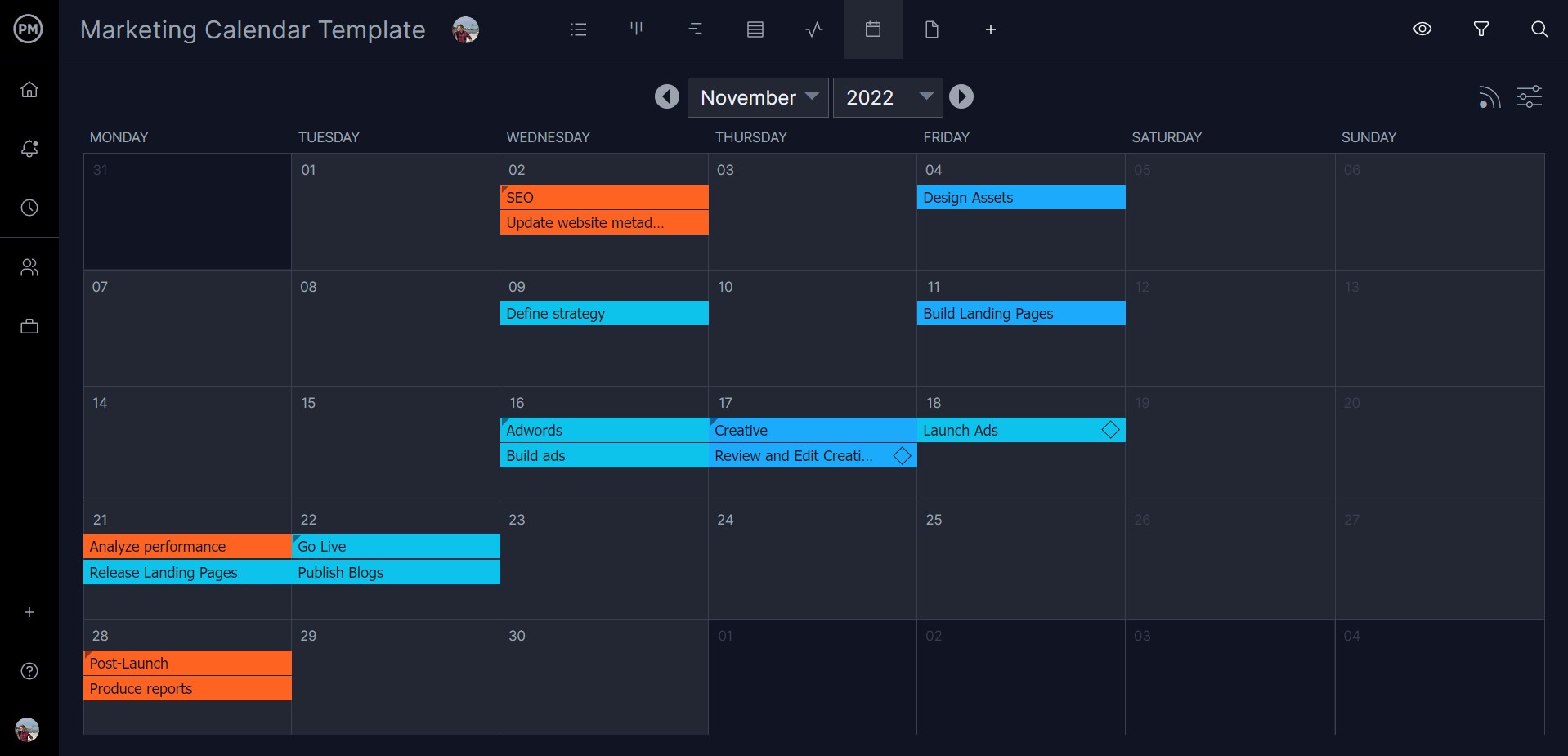Marketing is essential to connecting your product or service with an audience. But that process isn’t cheap. There are many marketing expenses such as ad buys, graphic work and copywriting to name only a few things. A marketing budget is how marketers know how much they can spend on their campaign.
Understanding how to create a marketing budget is a key element of any marketing plan. Once you’ve made the marketing budget, you have to track it to ensure you stay within your marketing budget. We’ll explain how to do that and even throw in a free marketing budget template to help you get started.
What Is a Marketing Budget?
A marketing budget is an outline of the costs that a company will spend to market its product or service, which is referred to as marketing spend. The marketing budget covers a finite period, the length of which can be anywhere between a quarter to a year.
The marketing budget includes all expenses related to the advertising campaign. These can include paid advertising, sponsored web content, additional marketing staff, registering a domain and building a dedicated website, print and billboard advertising, TV ads and much more.
Budgeting is a crucial part of any marketing plan; you need to allocate your resources properly to meet various marketing strategies that your company sets. It’s a complicated job that’s simplified through project management software.
ProjectManager is online project management software that helps you plan and track your marketing budget. Our Gantt chart helps you organize your tasks, resources and marketing costs. Once you have a marketing plan and set the baseline, you can track the planned costs versus actual costs in real time. Keep to your marketing budget—get started with ProjectManager today for free.
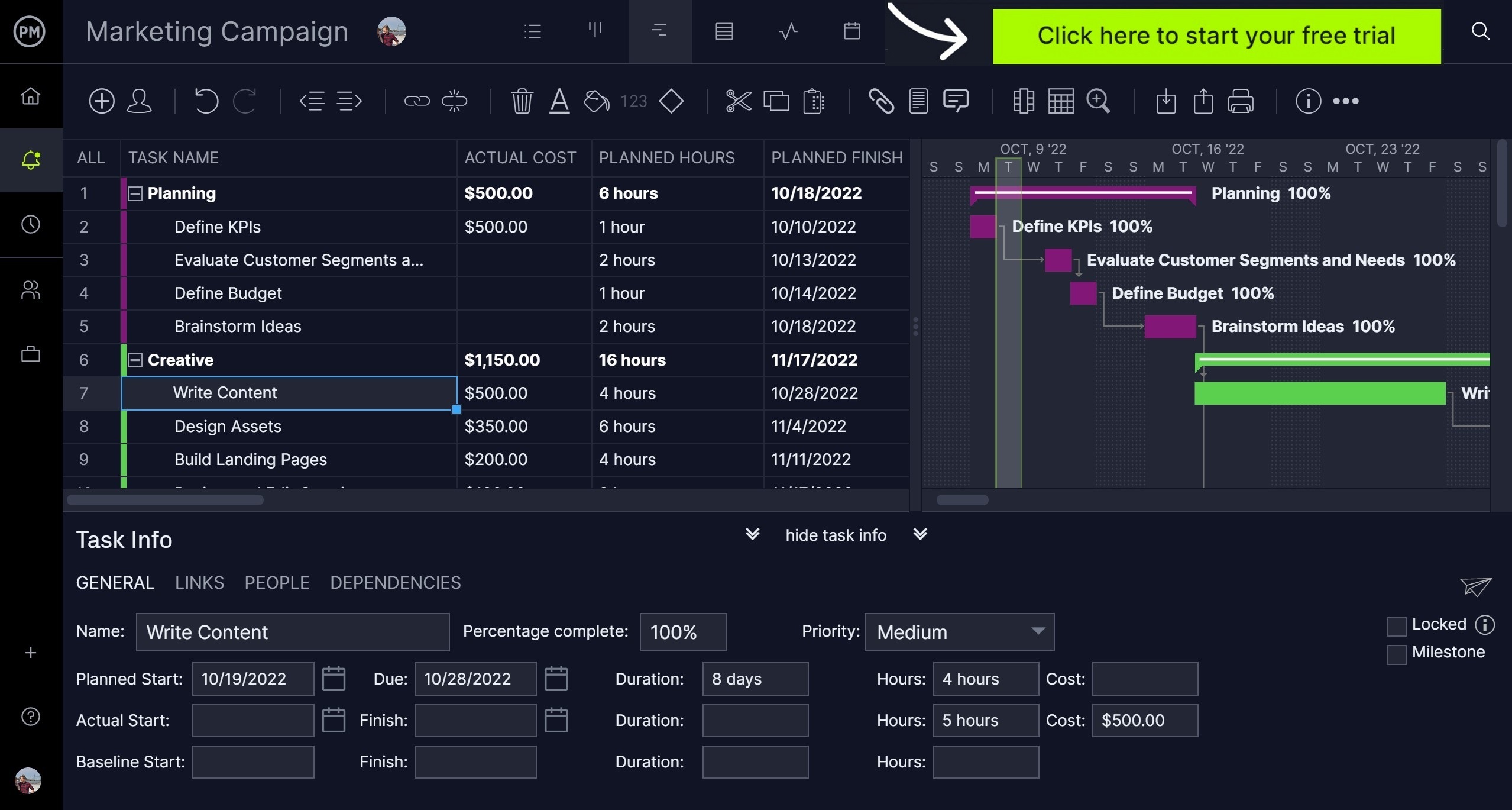
How to Create a Marketing Budget
Creating a marketing budget is an essential part of planning your marketing plan. Without the funds, your efforts will fall short. Below are the steps you should take when building a marketing budget for one or more campaigns over the quarter or year.
1. Set Marketing Goals & Objectives
Your goals and objectives should be SMART. That’s an acronym for specific, measurable, attainable, relevant and time-bound. For a marketing budget, you need to think about your sales funnel and devise short- and long-term goals while setting key performance indicators (KPIs) to track your performance.
2. Conduct Market Research
You don’t want to go into the marketplace without a clear picture of the market. You need to conduct market research to understand your target audience. That includes demographics, customer needs and so forth. But don’t neglect the competition as they’re vying for the same customers as you are. Identify the competition and list what you have in common with them and how you can differentiate yourself.
3. Develop Your Marketing Campaign
The budget depends on the concept you’ve chosen to deliver the message about your product or service. That message must align with the overall strategy of your company. Once you have made these decisions, the related costs will become clear, such as ad materials, graphic design, art or photography and so forth.
4. Choose Marketing Channels
Your message will be most effective on specific channels depending on the target audience you’re trying to reach. This requires some research to determine if your audience is swayed by social, email or content marketing, just to name a few.
5. Estimate Marketing Costs
A marketing budget is a forecast of how much you think you’ll spend. But once that budget has been approved, you’ll have to stick with it, so your estimates must be accurate. There are many techniques to help you estimate your marketing costs, from revenue-based to competition-matched, top-down and goal-driven. You might also use a combination of these techniques.
6. Develop a Marketing Budget
Once you’ve gone over these five steps, you can begin to put together your budget with the resources and costs you’ve determined. These will have to be tied to the larger marketing plan. For example, resources will have to align with a schedule so teams have what they need when they need them. The marketing budget is part of the marketing plan and will be developed together.
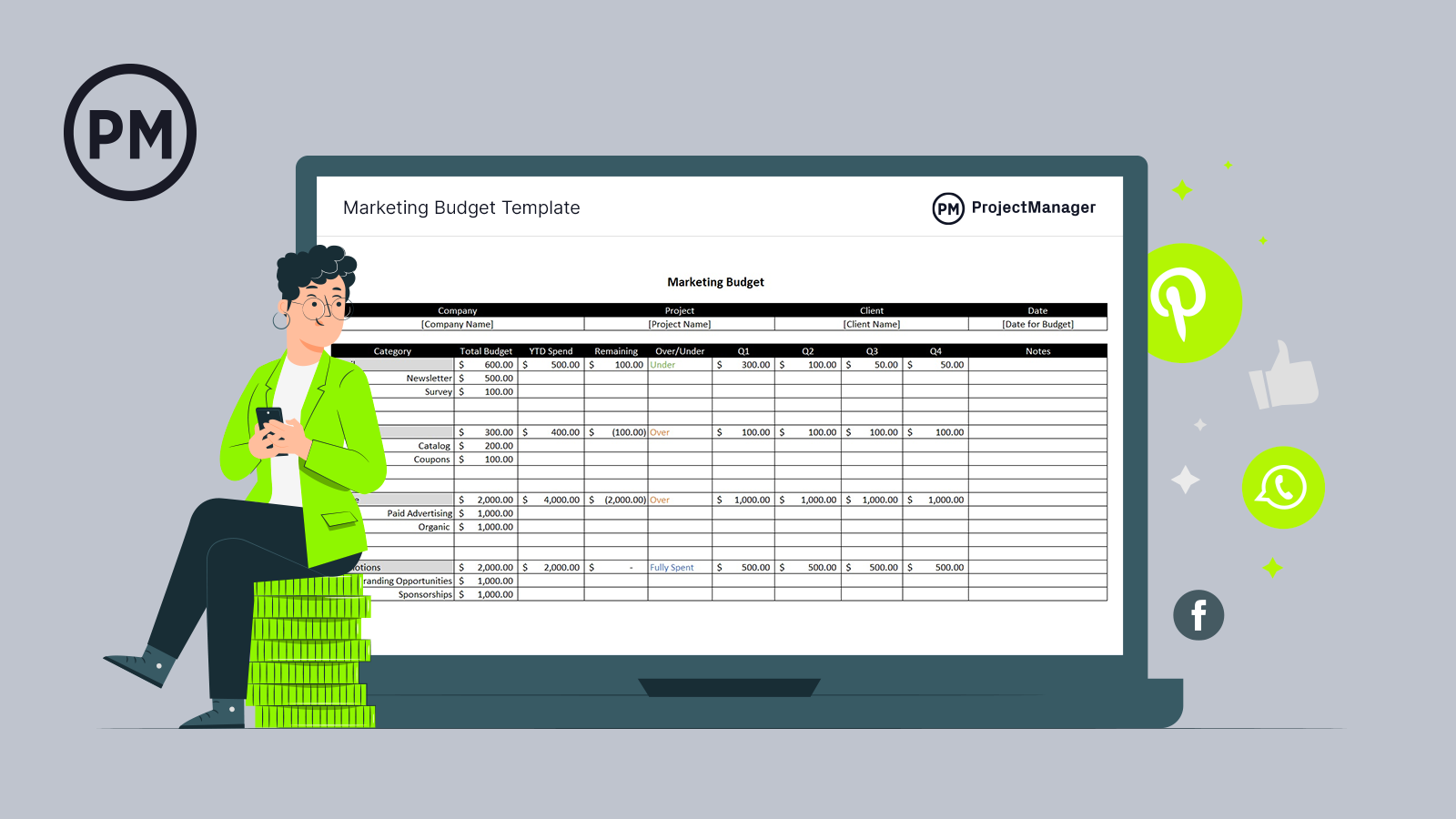
Get your free
Marketing Budget Template
Use this free Marketing Budget Template for Excel to manage your projects better.
Marketing Budget Example
Marketing expenses vary from one organization to another, depending on their approach to reaching potential customers. Some of them invest most of their budget in digital marketing resources, while others prefer traditional methods of advertising such as radio or TV ads.
Having said this, there are certain expenses that many businesses have in common. Here’s a marketing budget breakdown example to better understand what marketing expenses can go into a marketing budget.
Staffing, Office & Supplies
The wages of marketing employees who will carry out all the marketing activities. This could also include the cost of hiring agencies or consultants for specific activities such as paid advertising or search engine optimization (SEO).
There’s also the cost of renting an office, which can be easily avoided by having a remote team. In that case, most organizations will pay their employees’ internet connection fees and provide certain office supplies such as computers, tablets or phones.
Software
In most cases, marketing teams use dozens of marketing software tools for most processes such as customer relationship management, creating and publishing digital content, managing websites, analyzing business data, etc.
Website
Every business needs a website to reach its potential users and sell its products or services online. For many companies, websites generate a major part of their revenue and in the case of e-commerce businesses, websites replace brick-and-mortar stores.
Because of the impact they can have on a business, websites are critical areas for marketing budget allocation as they generate expenses such as:
- Content marketing: The wages of employees who create digital content such as web pages, ebooks, infographics, videos and other types of multimedia resources.
- Content management system (CMS): Software that allows users to manage the content that is uploaded in a website without requiring the technical knowledge required to code.
- Content delivery network (CDN): Network of servers that allow websites to be shown to users promptly throughout the globe.
- Web hosting: Infrastructure needed to host the data that makes up a website in a physical server, which is needed to show it on the internet.
- Paid Ads: Digital ads shown in search engines, websites and social media platforms.
- SEO: Software and functional experts are needed to optimize a website to improve its visibility and user traffic obtained from search engines.
Other Digital Marketing Expenses
There are other expenses related to managing the digital presence of a business besides running a website.
- Email marketing: Staff and specialized software are required for sending emails in large volumes and using complex sequences.
- Social media marketing: Cost of making content, engaging with users online, scheduling posts, investing in paid ads, among many other activities required to manage social media profiles.
- App development: Most if not all organizations hire an external company to develop their mobile apps. After it’s been created, the mobile app will generate costs over time.
Marketing Budget Template
While a marketing budget template isn’t going to give you real-time data and will require you to manually input all your financial information for the marketing campaign, it’s still a good start if you don’t have project management software. Our free marketing budget template for Excel is a great tool to help you manage your budget. You can break up your spending over quarters and view the year-to-date spending against your total yearly budget.
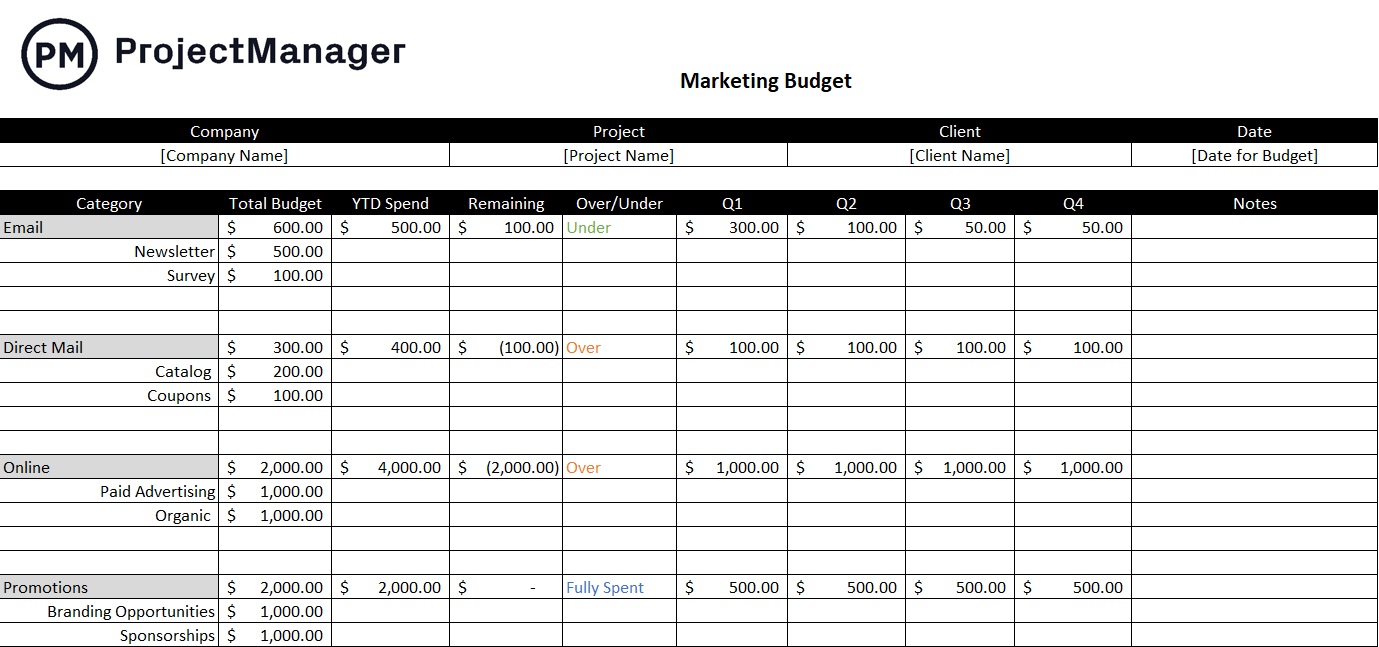
Use our free marketing budget template to organize the money you’ve allocated to marketing initiatives, whether paid advertising, sponsored web content, marketing personnel and so forth. You can use our free marketing budget template as a strategic tool when spending across your marketing channels. Use our free marketing budget template when you strategize your marketing for the year and turn creative ideas into financial realities.
Other Forms of Advertising & PR
These are the costs of other types of advertising such as press releases, printed materials, radio, TV and organizing, sponsoring or participating in events such as conventions or conferences.
How to Determine the Ideal Marketing Budget Allocation for a Business
The marketing budget allocation is how much funding is designated for each marketing expense in the budget. As noted, it’s a figure that the marketing budget cannot exceed. If the marketing budget allocation isn’t well defined, some marketing activities will take the resources allocated for other purposes, which will affect the operations of the marketing team.
A marketing budget allocation is used to estimate revenues and expenditures for various marketing activities over a time period. Marketing management teams use this when planning and figuring out how to allocate their financial resources for the best results in terms of leads, sales and other KPIs that will deliver a return on investment (ROI) for the company.
The marketing budget allocation is usually done annually, though it can be quarterly, and revenues are estimated to determine how many resources will be employed over that budgetary period. This informs the marketing spend, which is usually divided into departments and program units to make it easier to identify necessary resources.
Every business needs a marketing budget, but how do they calculate how much money should be spent on marketing? The short answer is, it depends.
How to Determine the Ideal Marketing Budget Size for a Business
The size of the marketing budget of an organization will depend on many things, such as the average marketing budget of its industry, its business strategy, its growth stage and the availability of financial resources.
However, certain rules of thumb can be followed. For example, most organizations determine their marketing budget by allocating a percentage of their estimated revenue to it.
What Is the Average Marketing Budget for a Small Business?
For example, startups and small businesses with low market recognition need a high growth strategy that requires a marketing spend from 30% to 50% of their total revenue, until they position themselves in the market which will allow their revenue to rely less on their marketing efforts and more on their brand recognition.
Once they’ve reached a point of moderate or stable growth after establishing themselves as a trusted brand in a particular market niche, they can reduce their marketing spend to 10% to 15% of their revenue.
However, there are many other factors to consider. For example, the company’s marketing budget may grow year over year if there are events such as the launch of a new product or service, or major changes in the business strategy such as a rebranding or a strategic partnership.
Tracking Your Marketing Budget
The idea of tracking your budget is an essential part of managing the marketing initiative. You’ve spent a lot of time and effort planning the budget, but that doesn’t mean your work is done. A marketing budget, like any part of your larger marketing plan, is not chiseled in stone. It’s a living document that must be constantly reviewed and revised.
First, create a baseline or benchmark for the budget. That is, you have to capture those planned costs and expenditures so you have something to compare against when you’re executing your marketing plan. Without taking this step, you could overspend. For example, if you don’t know your photography budget and the photographer comes back with more costs, you’re going over budget.
That doesn’t mean that costs are frozen, but having a baseline means you know when you’re going over your budget and can adjust the scope of your campaign or the schedule to make up for the added funds spent in photography, as in our example.
Everyone on the marketing team is going to have money earmarked for their tasks, but the marketing manager has the final say. The team can have some anatomy, but for efficiency and transparency, there should be a centralized purchasing process in which the manager is in control.
It’s also best to have software that delivers real-time data. You don’t want to know that money was spent days ago, you need that information immediately. Having real-time data means managers can make more insightful decisions when managing their budgets.
ProjectManager Tracks Marketing Budgets
Unlike templates, ProjectManager is online project management software. That means our tool updates in real time and even automates workflows that you set up. We have task approval settings to ensure that nothing moves forward until it’s been reviewed for quality assurance.
Schedule Your Marketing Campaigns
While marketing managers want to use robust Gantt charts to schedule marketing campaigns, not everyone uses this tool to execute their work. Our multiple-project view means you can use what you want and all views are updated in real time. For example, a calendar view captures events that are easy to see at a glance.

Track Marketing Costs In Real Time
Of course, seeing events and activities is important, but so is tracking that work. It’s how you keep to your budget. Once you set a baseline on your marketing plan, you can view planned versus actual effort on the real-time dashboard. No setup is required. You get a high-level view of six metrics whenever you want, from costs to workload and more.

Manage Teams, Time & Resources
There are a lot of ways to spend money on a marketing campaign, and marketing managers have to stay on top of all of them. Resources can be tracked on the Gantt chart while human resources can be balanced on the workload chart. To keep track of how much time your team is spreading on their tasks, use our secure timesheets. They not only streamline payroll but help you keep track of invaluable time.
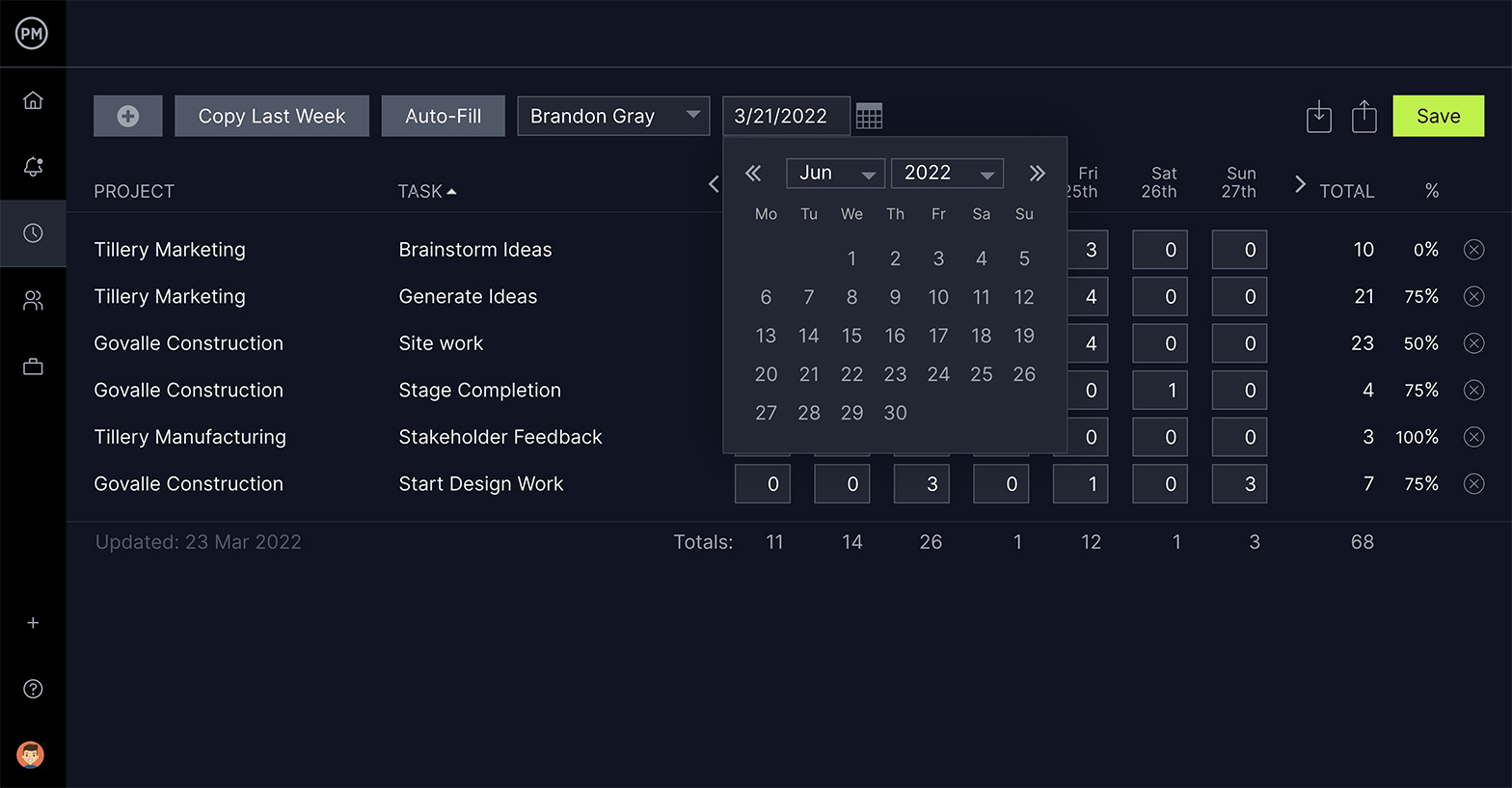
Marketing budgets fund a variety of departments and even outside vendors. You can connect sales, marketing and your art department as well as any contractors on our collaborative platform. Anyone can share files, add comments and tag other team members to get their input. It’s all done in real time so whether you’re working in the office, at home or anywhere, you’re able to work better together.
Related Content
Creating and managing a marketing budget can be challenging. That’s why we’ve created blogs, templates, guides and more to help you streamline your marketing management process.
- 10 Free Marketing Templates for Excel, Word and More
- What Is Marketing Management: An Essential Introduction
- What Is a Marketing Plan and How Do I Make One (Template Included)
- Marketing Implementation 101: How to Implement Your Marketing Plan
- How to Create Marketing Budget: A Quick Guide
- How to Write a Creative Brief
- Push vs. Pull Marketing: A Quick Guide
ProjectManager is award-winning software that helps marketing departments plan, schedule and track their campaigns in real time. Plan and track time and budgets to keep your costs in control. Join teams at NASA, Siemens and Nestle who use our software to save money. Get started with ProjectManager today for free.

